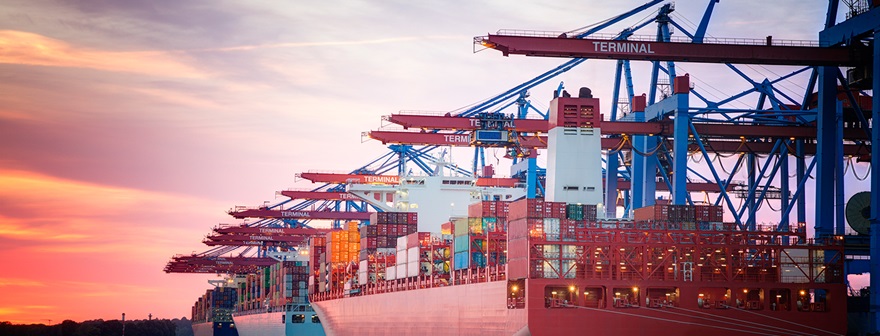
ASEAN Rises to Become China's Top Trading Partner, Great Prospect for China + ASEAN Strategy
Back to The Belt and Road InitiativeArticle reposted from 21CBN
Wechat account
As the global supply chain is undergoing profound changes wrought by the COVID-19 pandemic, risks are being exposed. Some analysis points out that the current global supply chain is too long and over-segmented, which highlights the pressing need for regional integration. That process is increasingly taking place between China and ASEAN.
Since the beginning of this year, ASEAN has risen to overtake the EU as China's top trading partner despite global repercussions of the COVID-19 pandemic. Statistics for January through May show that trade between China and ASEAN reached RMB 1.7 trillion, up 4.2% yoy, accounting for 14.7% of China's total foreign trade. In terms of investment, from January to April this year, China's non-financial outward direct investment (ODI) in ASEAN reached US$3.94 billion, up 43.3% yoy and more than three times the growth rate of China's investment in 53 countries along the "Belt and Road (BRI)". At the same time, ASEAN's investment in China has increased by 13% yoy. This is fairly impressive given the 6.1% contraction of China’s utilized FDI in the first four months of this year.
"Those statistics have highlighted the potential and resilience of China-ASEAN cooperation against the backdrop when the US and Europe are yet to rebound their economies due to the pandemic. According to HSBC’s observations, more and more Chinese corporates are gradually coming out of the crisis and beginning to plan their next step in the new economic environment. In other words, they are quickly adapting to the changes of the global supply chain and trade." said Frank Fang, EVP and Head of Commercial Banking, HSBC China, on 17 June during the session themed "Supply Chain: the ASEAN Option" as part of 2020 HSBC China ASEAN Corridor Webinar Series.
Strong Complementarity between China and ASEAN
On one hand, the ASEAN market offers great potential. Combined as one, ASEAN is one of the fastest-growing leading economies in the world.
As of 2018, the 10 ASEAN countries had a combined population of close to 650 million, a total GDP of nearly US$3 trillion and a growth rate of 5.2%, significantly higher than the rest of the world. Although the region’s GDP per capita currently stands at US$4,308, a June report published by World Economic Forum shows that 70% of the ASEAN population will become middle class by 2030.
As a production base, ASEAN features a number of well-recognized comparative advantages, including demographic dividends and low labor costs, all of which are attracting increasing foreign direct investments (FDI) into the region. In 2018, ASEAN’s FDI inflow reached a record high of US$149 billion, up 3% yoy.
"The average wage level in China is about 2-3 times that of Indonesia, and if you compare it to some countries like Vietnam and Cambodia, the gap may be bigger." said Erry Hardianto, Area Managing Director, A.P. Moller-Maersk.
Among foreign investors entering ASEAN are some Chinese corporates. According to Sonklin Ploymee, Acting Senior Executive Advisor, Board of Investment Thailand, over the past few years, Thailand has attracted more FDI from China. Chinese companies in industrial sectors such as electronics, home appliances, auto parts, solar panels are investing in Thailand so that they can manage their supply chain outside of China or enter new markets.
Aside from lower labor costs, ASEAN has another major advantage in the form of free trade agreements (FTAs). In October 2019, the China-ASEAN FTA Upgrading Protocol took full effect as the outcome document of the two economies’ negotiations on FTA upgrading. Within the framework of the China-ASEAN FTA, more than 90% of goods from China and ASEAN are subject to zero tariffs. In addition, ASEAN has signed bilateral FTAs with Hong Kong SAR, Australia, India, Japan, New Zealand and Korea.
From August 1 this year, the Vietnam-EU Free Trade Agreement and the Vietnam-EU Investment Protection Agreement will enter into force, under which about 99% of tariffs in Vietnam-EU bilateral trade in goods will be phased out within the next 10 years.
In addition, the 15 member countries of the Regional Comprehensive Economic Partnership (RCEP) are aiming to officially sign the agreement this year, and remain open to India's participation. Within RCEP, over 90% of trade in goods will be fully liberalized, covering half of the world's population. The partnership will account for about 32.2% of the global GDP and about 29.1% of the world trade.
"For some manufacturing companies, setting up production hubs in ASEAN can fully benefit from the region’s FTAs. So can those from China." said Erry Hardianto, Area Managing Director, A.P. Moller-Maersk.
Faced with the influx of FDI, ASEAN is improving its investment environment. As a unified tax rate regime is elusive under the ASEAN Economic Community (AEC) Integration Agreement, its member countries are trying to trying to attract more FDI with preferential tax rates.
"Vietnam offers many incentives for foreign investments. For instance, on the 20% corporate income tax, if you build a factory, you will be exempted from paying corporate income tax for the first two years and enjoy a 50% reduction for the next four years. It is possible to set up a wholly foreign-owned firm and easy to move money in and out of the country." said Michael Chan, Country Head of Sales & Marketing, BW Industrial Development JSC Vietnam.
According to Sonklin Ploymee, Thailand is currently working on the Eastern Corridor Economic Program (EEC), hoping to create a high-tech cluster. The government also provides incentives for 13 key industries such as next generation automotive, medical and aviation, etc.
Opportunities and Challenges
Investing in ASEAN also faces challenges. One is the lack of a complete supply chain locally. " Thailand still imports some of raw materials and intermediates for production. They come from Japan, Korea, China and some other countries. That may have constraints in production of some products. If you come to Thailand to invest and diversify your supply chain, I would suggest exploring with your suppliers to invest together." said Sonklin Ploymee.
This is also a problem in Vietnam. According to Michael Chan, Vietnam doesn’t have a complete supply chain. So some large foreign firms would invest together with their upstream and downstream partners when entering the market. This is to ensure that they can set up an ecosystem locally. However, the geographical proximity between China and ASEAN can alleviate these problems to some extent. "In less than 24 hours, semi-products and raw materials can be transported from China to Vietnam and the cost of land transporation is low."
Besides the problem of local supply chain, lack of technical talent is another major challenge. According to Sonklin Ploymee, Thailand also need to invite more foreign talent because of its policy to promote investment in high technological industries and hopes to work with investors to facilitate the investment in the targeted sectors.
A third major challenge is ASEAN’s infrastructure. "Vietnam's infrastructure is still relatively poor at the moment, with only 24% of the country's roads paved and transport networks not particularly accessible. So when choosing a specific location to invest in, it's important to ensure that you are geographically close to your upstream and downstream suppliers." said Michael Chan.
Nonetheless, with the implementation of the BRI, it is expected that ASEAN's infrastructure will continue to be improved and connectivity will further facilitate seamless and stable bilateral trade. ASEAN is a key region under the BRI. Now China-ASEAN relations have entered a new stage featuring all-round development. All 10 ASEAN countries have signed the BRI Cooperation Document with China. And Chinese companies have cumulatively invested over US$100 billion in the region, built 25 economic and trade cooperation zones and created more than 100,000 local jobs.
Take the China-Singapore (Chongqing) Demonstration Initiative on Strategic Connectivity as an example. The initiative was launched in 2015. In late June this year, Lui Tuck Yew, Ambassador of Singapore to China, said that since the COVID-19 outbreak, the "New International Land-Sea Trade Corridor" under the initiative has become an effective new trade link between Southeast Asia and China’s western region. With that, bilateral trading routes and supply chain have become more resilient, and necessities such as food and medical supplies are undergoing fluid flows.
Statistics so far this year have already reflected possibilities of deeper integration of supply chains between China and ASEAN. According to information published on the official website of the China-ASEAN Business Council, in the first quarter of 2020, China imported US$14.9 billion worth of integrated circuits (ICs) from ASEAN countries, up 25 percent yoy. The import mainly includes chip capacitors, micro-processor chips and analog-to-digital converters. At the same time, China exported about US$6 billion worth of ICs to ASEAN, up 28% yoy.
According to relevant analysis, some Japanese and Korean manufacturers are relocating their supply chain to ASEAN by setting up IC plants in countries like Vietnam and Malaysia so as to meet the demand of the Chinese market. But that doesn’t mean the relocation of the entire value chain of the manufacturing industry to ASEAN. Rather, it’s an extension of the value chain from China. Many manufacturing hubs still need to import raw materials, equipment and technologies from China. At the same time, they rely on China as a major consumer market.
ASEAN to Remain a Hotspot for Chinese Investments
The pandemic will continue to push companies in all countries to re-examine their existing sourcing and supply strategies to diversify risks. Given the complementary industrial structures between the two economies, cost advantages of inter-regional logistics and further institutional dividends under RCEP, bilateral trading relations between China and ASEAN are expected to be further strengthened. Against this backdrop, ASEAN is expected to continue to be a hotspot for Chinese corporate investments in the aftermath of the pandemic.
"China and ASEAN will continue to consolidate and reshape their supply chains and covert more capacity into production. They will also continue to develop and expand multi-lateral trade and even build a new value chain. Both will play an essential role in global economic recovery." said Frank Fang, EVP and Head of Commercial Banking, HSBC China.
Over the past more than 150 years, HSBC has played an active role in ASEAN’s economic and infrastructural development. Today, the Bank’s network covers over 93% of the region’s GDP and external trade with 200 banking outlets serving 10,000 large corporates, 20,000 SMEs and 2.5 million retail customers across 6 major markets in ASEAN.
HSBC has also set up China Desks in key ASEAN markets to help Chinese corporates achieve a new wave of business growth in the region by providing in-depth local knowledge and forward-looking insights. Leveraging our connectivity in ASEAN and beyond, the Bank can link our customers with business opportunities and provide locally relevant solutions and one-stop banking services. We also explore innovative technologies such as the blockchain to help customers embrace a future of rapid changes.
"The resilience of supply chains has been brought to the forefront during the current crisis. From a banking perspective, there will increased focus on digital solutions. There will be increased need to be able to finance the multiple levels of supply chains – not just in China, but also worldwide. Cross-border digital connectivity is real and an area of focus" said Ajay Sharma, Regional Head of Global Trade Solutions, HSBC.
2020 HSBC China ASEAN Corridor Webinar Series
Suppy Chain: The ASEAN Option
Contact us
HSBCnet Service Hotline
400 821 8878
Hotline for Commercial Banking Customer. Customer from Global Banking please contact your Customer Service Manager directly.
HSBC China Business Official WeChat Accounts

HSBC China Business WeChat Subscription Account
A thought leadership content hub that shares market trends, expert insights, industry reports, and global sponsorship news.

HSBC China Business WeChat Service Account
Scan QR code to follow.
HSBCnet Mobile App

iPhone

Android


